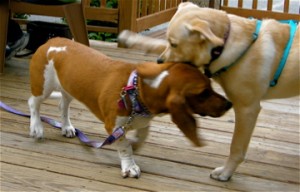Is your dog ready for a disaster? by Jaye McElroy (click here for more)
Disasters can be made worse if you are not prepared.
Natural disasters, terrorist acts or even a technical disaster, are all real threats and can happen at any time. Without being all doom and gloom, the reality is we all might have to be evacuated and forced to leave our homes for a few days or even weeks. The spring floods of 2010 in Rhode Island was a forced reality for many people and their animals. Taking a few minutes today to get your dog(s) things together can make your life a lot easier.
Here are a few suggestions for creating a packable bag, backpack or plastic container that has all your dog’s stuff packed into it and ready to go in a relatively short amount of time. First, contact your local public shelter ahead of time to see if pets are permitted. If you do not have a pet friendly shelter in your area, ask a family member or friend ahead of time if you and your dog can stay with them. Have the phone number of an out-of-state motel/hotel that takes dogs. Call as soon as you think you are leaving to see if they have any rooms available.
Please remember: Your dog will be allowed in a pet-friendly public shelter ONLY if he is properly identified, healthy and restrained on a leash or in a carrier.
Item checklist for your kit:
-Copy of the most recent receipts from the vets, proof of rabies is the most important. If there are known health concerns, have their medications packed.
-Current ID, license and rabies tags should be on your dog, especially if they don’t wear them on a daily basis. ID tags should be worn on your dog at all times.
Tip: If your dog is micro chipped, make sure current information is up to date.
– Two recent photos, one of the dog alone and one of you/your family with the dog. Have the photos clearly labeled on the back. These are helpful if you are separated from your dog for any length of time.
Contact information of family or destination of where you are heading (friend or relative who lives a safe distance away.)
Tip: A large ziplock baggie works great for all these papers and photos. Print dog’s name and your family’s last name on the outside, cell phone if you have room.
In your dog’s kit you should put the following, remember to replace and keep fresh every 6 months.
Food & Water — 3-5 day supply for each dog.
Food: Most dog foods come in a 4-6 lb. bag that would be ideal to pack in your kit. Or you can repackage larger bags of dry dog food in quality zip lock bags with date and dogs name on the outside. Dog food cans stay fresh much longer, store in a cool, dry place. Don’t forget a small can opener if you don’t have pull tops. Also, keep a bag of your dog’s favorite treats in a sealed baggie or small Tupperware-like container. Most treats will also stay fresh for up to a year if stored properly.
Water: Write dog’s name on water bottles, gallon jugs work best. One gallon per day, depending on the dog’s size and time of the year. 
Dog bowls: one for water and one for food. You don’t really want to share bowls with other dogs and you might have to keep them in your dog’s crate. Keep your bowls well marked with your dog’s name or your family’s name.
Tip: Sharpie pens work great on all of the above items!
Beds and/or blanket: Space might be tight, so a favorite bed or blanket could be comforting for your dog. Also, tuck away one or two of your dog’s favorite toys for comfort and stress relieving moments.
Poop bags: You don’t want to be the one who forgot the poop bags, trust me. Also pack newspapers and paper towels in case of accidents.
Flashlight with batteries: A headlamp for the human would be great. Otherwise, bring what you have in the junk draw, but have new batteries in a baggie. Also, Pet Blinkers are a good thing to have on your dog’s collar. They are inexpensive and are very helpful at night, outside…in a storm or crisis situation.
Leash: Bring two, you could lose yours or be a hero to someone who has lost theirs.
The first aid kit: This kit must be prepared ahead of time. Items to include are bandages, gauze, self-sticking pet wrap (ask your vet for a ½ roll it is amazing and easy to use. Don’t be shy to ask, pay for it if you must, it’s worth it.) Also include tweezers, a small tube of super glue (for cuts on their pads), benedryl tablets, and a small pair of scissors. This can also be the first aid kit when you hike with your dog, go to the beach or go on vacation with your dog.
Tip: You can modify a human first aid kit fast and easy.
Dogs get stressed just like people. They show it with bad behaviors such as indoor peeing or pooping, excessive barking, growling, howling and/or whining. Comforting your dog should be something you already do, know what you can and can’t do to help your dog. 
You are your dog’s advocate, be the human you need to be to protect and care for your dog.
“He is your friend, your partner, your defender, your dog. You are his life, his love, his leader. He will be yours faithful and true to the last beat of his heart. You owe it to him to be worthy of such devotion.” — Unknown
All photos copyright by jaye McElroy, The Phodography Studio, 2010.
